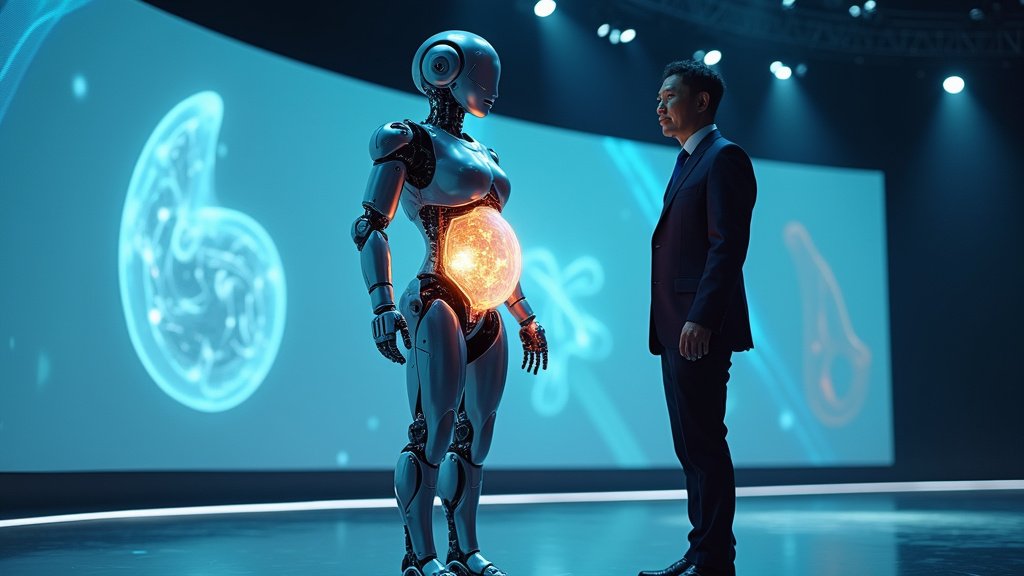A groundbreaking announcement from China has captured global attention, signaling a potential paradigm shift in human reproduction and the very definition of family. At the 2025 World Robot Conference in Beijing, Chinese scientists unveiled plans for the world’s first humanoid robot designed to carry a fetus to full term, a development poised to reshape the future of parenthood. This featured technological leap, dubbed a “pregnancy robot,” is sparking viral discussions and profound ethical questions worldwide.
The Genesis of a New Era
The innovative project is spearheaded by Kaiwa Technology, a Guangzhou-based tech firm, under the leadership of its founder, Dr. Zhang Qifeng. Dr. Zhang, who is also affiliated with Singapore’s Nanyang Technological University, publicly presented the concept, confirming plans for a prototype debut in 2026, with a target market release the same year. The estimated cost for this revolutionary device is projected to be around 100,000 yuan, approximately $13,900 to $14,000 USD, positioning it as a potentially more affordable alternative to traditional surrogacy.
How the “Gestation Robot” Works
At its core, the pregnancy robot is a humanoid system incorporating an artificial womb within its abdominal cavity. This artificial uterus is engineered to meticulously replicate the entire gestation process, from conception through a full ten-month pregnancy to eventual delivery. The fetus would develop in an environment filled with synthetic amniotic fluid, receiving essential nutrients via a tube that mimics the function of a human umbilical cord. Dr. Zhang asserts that the underlying artificial womb technology is already in a “mature stage” in laboratory settings, with significant success demonstrated in animal experiments. The current focus is on seamlessly integrating this advanced womb into a humanoid form to facilitate human-robot interaction throughout the pregnancy journey.
Addressing Infertility and Societal Shifts
The primary impetus behind this ambitious development is to offer a new pathway to parenthood for individuals and couples facing challenges such as infertility, which globally affects an estimated 15 percent of couples. China, in particular, has seen its infertility rates rise from 11.9 percent in 2007 to 18 percent in 2020. Beyond addressing medical needs, the pregnancy robot is also being presented as an alternative for those who wish to avoid the physical and emotional burdens associated with biological gestation.
A Legacy of Artificial Womb Research
While Kaiwa Technology’s humanoid pregnancy robot marks an unprecedented leap, the concept of artificial wombs is not entirely new. The project builds upon earlier foundational research, most notably the 2017 experiment at the Children’s Hospital of Philadelphia. In that study, premature lambs were successfully nurtured within a “biobag” system, demonstrating the viability of external uterine support for early-born individuals. Furthermore, in 2022, researchers in Jiangsu Province, China, developed an AI-powered “nanny robot” to monitor animal embryos within artificial wombs, highlighting China’s ongoing investment in reproductive technologies. However, experts emphasize that transitioning from supporting premature fetuses to achieving full-term human pregnancy from conception outside the body remains a monumental scientific hurdle.
Ethical Quandaries and Regulatory Horizons
This breaking news has ignited a fervent global debate, touching upon profound ethical, legal, and societal implications. Critics voice significant concerns regarding the potential impact on fetal-maternal bonding, the psychological well-being of children born via this method, and the ethical sourcing of eggs and sperm. Many argue that the technology is “unnatural” and could fundamentally violate human ethics, with some feminist theorists even positing it could diminish the unique role of women in reproduction. Questions have also been raised about the ability to replicate complex biological processes critical to human gestation, such as maternal hormone secretion and immune system interactions.
Recognizing these complex challenges, Dr. Zhang Qifeng’s team is actively engaged in discussions with authorities in Guangdong Province. They have submitted proposals and held forums to navigate the intricate landscape of policy and legislation required for such an innovation. This proactive engagement is crucial, as current Chinese law prohibits developing human embryos in an artificial environment for more than 14 days, and commercial surrogacy is already banned, indicating the need for significant legal revisions for the technology to progress with human gestation.
Public Reaction and Future Outlook
The news has become a top trending topic on Chinese social media, eliciting a polarized response. While critics express alarm over the detachment from traditional family structures and the commodification of life, a significant number of supporters, particularly those grappling with infertility, have expressed enthusiastic optimism. They view the pregnancy robot as a liberating technology that could free women from the physical strain and risks of pregnancy, offering hope for a new path to parenthood.
As Kaiwa Technology moves towards its 2026 prototype launch, the world watches on. This ambitious endeavor not only pushes the boundaries of robotics and reproductive medicine but also forces a crucial societal conversation about the future of human reproduction, parenthood, and the very essence of what it means to give and sustain life. This news underscores China’s bold advancements in AI-driven biotechnology, setting a precedent for global discussion and ethical frameworks in the coming years.





